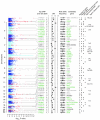Multiple sclerosis
- PMID: 22466660
- PMCID: PMC3314452
- DOI: 10.1172/JCI58649
Multiple sclerosis
Abstract
Multiple sclerosis (MS) is a multifocal demyelinating disease with progressive neurodegeneration caused by an autoimmune response to self-antigens in a genetically susceptible individual. While the formation and persistence of meningeal lymphoid follicles suggest persistence of antigens to drive the continuing inflammatory and humoral response, the identity of an antigen or infectious agent leading to the oligoclonal expansion of B and T cells is unknown. In this review we examine new paradigms for understanding the immunopathology of MS, present recent data defining the common genetic variants underlying disease susceptibility, and explore how improved understanding of immune pathway disruption can inform MS prognosis and treatment decisions.
Figures




References
Publication types
MeSH terms
Substances
Grants and funding
LinkOut - more resources
Full Text Sources
Other Literature Sources
Medical

